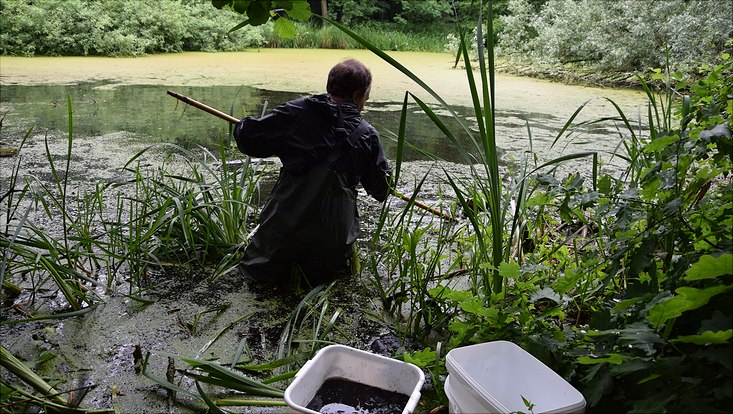
Bioblitz in Hamburgs Parks and Gardens
19 June 2020

Photo: UHH/CeNak, Wenzel
What are wild herbs, what are ornamental flowers, where does the park begin, and where do the woods end? Under the motto “Naturally Hamburg,” researchers from the Center of Natural History (CeNak) mapped urban gardens and parks on this year’s Langer Tag der StadtNatur Hamburg (long day of urban nature in Hamburg). They wanted to know what lives there and how it could become even vibrant. Due to the coronavirus, this year’s CeNak day of activities, with a look at the state of species in 3 areas and videos on field research, was short and mostly online—but above all species-rich.
In the 100-year-old Steenkampsiedlung in the Bahrendfeld district of Hamburg, various guests gather in the enchanted gardens: red poppies and greater celandine attract wild bees and the dead wood under the elderberry bushes turns out to be a natural place for insects to nest. “Private gardens make up a considerable percentage of the green areas in cities and are important biotopes. However, there is hardly any available data on animal and plant communities in these gardens,” says Martin Kubiak, entomologist at CeNak. The researchers at CeNaK want to change this. The data collected here during the species inventory in 19 gardens provides a first insight into their species diversity and is intended to form a baseline for comparison with subsequent inventories.
The experts identified several amphibian species in numerous gardens, including endangered species such as the common frog (RL HH: 3) and the toad (RL HH: V). According to Martin Kubiak, “These finds show how important structurally rich gardens are: having a certain number of small bodies of water ensures the preservation of amphibian species that are now less often able to find favorable conditions to survive in intensively used agricultural areas and thus are showing a decline in population.”
In keeping with the tradition of the GEO Tag der Natur, experts also found numerous insect species during the bioblitz activities on 13 June—for example, the hollyhock weevil. This is a beetle species that has multiplied in Central Europe since the end of the twentieth century and is found exclusively on hollyhock. Garden chafers, black-and-red bugs, and common carder bees were also sighted. “We are expecting to find even rarer species,” says Martin Kubiak, as the full assessment of animal groups that are species rich is not yet complete.
The species inventory in the gardens had two additional positive effects for Martin Kubiak: “Through the activities and thanks to their practical work, all those involved learned more about a number of species. In addition, we are working closely with students and citizen scientists to record species.” The final results will be available in late autumn. In the future, the experts and the residents of Steenkampsiedlung want to work together to preserve and further promote the biodiversity in their “garden city” by developing and discussing relevant strategies.
Recording species in the park and green area Obere Bille in the Bergedorf distrcit of Hamburg was also on the agenda. Fifteen zoology and botany specialists set out in diving suits or equipped with nets and pitfall traps and found what they were looking for. They identified numerous species and discovered a species that was thought to be an endangered species in Hamburg—the beautiful demoiselle (Calopteryx virgo). This species flourishes near oxygen-rich, shady streams—take, for example, the giant lacewings (Osmylus fulvicephalus), which though rare have been counted in larger numbers on the Bille river.
These finds show that the section of the Bille investigated is comparatively pristine as it is has a relatively large structural diversity and little water pollution. “Moist and wet meadows, which are uncommon, are also found in this area. For a park and green area, the occurrence of these biotope types, which are otherwise mainly found in nature reserves, is rather unusual,” says Martin Kubiak with surprise. “The extensive insect collections provide important information that helps us to identify maintenance and development measures necessary for the permanent preservation of these valuable habitats.”
Video: Recording Species and Ornithology in the Park and Green Area Obere Bille
Martin Kubiak and master’s student Timo Zeimet focused on nocturnal insects at 2 different locations. In the Schnaakenmoor, one of the last raised bogs in Hamburg, they observed rare species such as the small emperor moth—a moth species that is classified as endangered in Schleswig-Holstein. On the Alsterschleife in Poppenbüttel, Timo Zeimet—working together with NABU—caught a total of 34 moth species using a light trap.
Video: Current State of Species in Hamburg’s Schnaakenmoor
“We are happy that despite the difficult circumstances we were able to maintain the tradition of the GEO Tag der Natur this year and carry out some bioblitz activities. Unfortunately, many experts could not take part in person because of the coronavirus restrictions. For this reason, we are handing our finds on for further analysis. So we will have to wait a little longer this year for an exact species count. All nature fans who weren’t able to participate because of safety restrictions can now virtually explore the green areas of Hamburg with us.”
To all videos:
https://tagderstadtnaturhamburg.de
- Out in Urban Nature: Recording Species on the Bille in Bergedorf, Hamburg
- With Researchers in the Field: Biomonitoring in Moorfleet, Hamburg
- Luminous Evening in the Schnaakenmoor: Biodiversity Research in Hamburg’s Last Raised Bog
- Biodiversity Meets Garden Diversity: Biomonitoring in Hamburg’s Steenkampsiedlung
- Mudflat Hiking without Getting Wet in the Zoological Museum
Since 2017, CeNak has invited residents to come discover nature on a weekend in the middle of June. Important cooperation partners are the Langer Tag der StadtNatur, the Loki Schmidt Foundation, and the GEO Tag der Natur. A major goal is to draw attention to the importance of learning about species as well as to the threat posed to the diversity of habitats and plant and animal species.
More about the GEO Tag der Natur at the Langer Tag der StadtNatur
